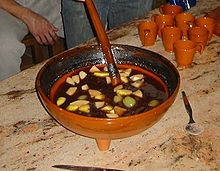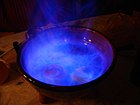Queimada (drink)

Multi tool use
Queimada is an alcoholic beverage of Galician tradition.

Queimada in preparation process.

Spell.

Queimada's characteristic blue fire.
Queimada is a punch made from Galician augardente (Orujo Gallego) - a spirit distilled from wine and flavoured with special herbs or coffee, plus sugar, lemon peel, coffee beans and cinnamon. It is traditionally prepared in a hollow pumpkin.
Typically, while preparing the punch a spell or incantation is recited, so that special powers are conferred to the queimada and those drinking it. Then the queimada is set alight, and slowly burns as more brandy is added.
Contents
1 Origins
2 Tradition
3 Spell
4 References
Origins
Although sometimes believed to be an ancient Celtic tradition transmitted along generations, some claim that the Queimada was actually developed in the 1950s.[1]
Queimada was initially prepared by groups of Galician emigrants in places like Madrid, typically after fellowship lunches and other group events. This was accompanied by theatrical revivals of old beliefs such as the reading of spells written ad hoc to keep witches away.
This ritual was so successful that it quickly became very widespread. Tito Freire designed in 1955 the clay pot in which Queimada is usually prepared and the spell that is recited nowadays was written by Mariano Marcos Abalo in the 1960s.[2]
Queimada is now part of the Galician tradition and considered as a sign of Galician identity.[3]
Tradition
The goal of the preparation ritual is to distance the bad spirits that, according with the tradition, lie in wait for men and women to try to curse them.[citation needed] All occasions are good for a queimada: a party, familiar meetings or gatherings of friends. After dinner, in the darkness of night, is one of the best times for it. The tradition also says that one of the perfect days to make the "conxuro da queimada" (spell of queimada) is in Samhain, the Celtic New Year's Eve. However, typically the queimada ritual takes place during St. John's Night or 'witches' night' on the 23rd of June.
The people who take part in it gather around the container where it is prepared, ideally without lights, to cheer up the hearts and to be better friends. One of them ends the process of making the queimada while reciting the spell holding up the burning liquid in a ladle and pouring it slowly back into the container.
Spell
| In Galician language |
In English |
|---|---|
Mouchos, curuxas, sapos e bruxas. Demos, trasgos e diaños, espíritos das neboadas veigas. Corvos, píntegas e meigas: feitizos das menciñeiras. Podres cañotas furadas, fogar dos vermes e alimañas. Lume das Santas Compañas, mal de ollo, negros meigallos, cheiro dos mortos, tronos e raios. Ouveo do can, pregón da morte; fuciño do sátiro e pé do coello. Pecadora lingua da mala muller casada cun home vello. Averno de Satán e Belcebú, lume dos cadáveres ardentes, corpos mutilados dos indecentes, peidos dos infernais cus, muxido da mar embravecida. Barriga inútil da muller solteira, falar dos gatos que andan á xaneira, guedella porca da cabra mal parida. Con este fol levantarei as chamas deste lume que asemella ao do Inferno, e fuxirán as bruxas a cabalo das súas vasoiras, índose bañar na praia das areas gordas. ¡Oíde, oíde! os ruxidos que dan as que non poden deixar de queimarse no augardente quedando así purificadas. E cando este beberaxe baixe polas nosas gorxas, quedaremos libres dos males da nosa alma e de todo embruxamento. Forzas do ar, terra, mar e lume, a vós fago esta chamada: se é verdade que tendes máis poder que a humana xente, eiquí e agora, facede que os espíritos dos amigos que están fóra, participen con nós desta Queimada. |
Owls, barn owls, toads and witches. Demons, goblins and devils, spirits of the misty vales. Crows, salamanders and witches, charms of the folk healer(ess). Rotten pierced canes, home of worms and vermin. Wisps of the Holy Company, evil eye, black witchcraft, scent of the dead, thunder and lightning. Howl of the dog, omen of death, maws of the satyr and foot of the rabbit. Sinful tongue of the bad woman married to an old man. Satan and Beelzebub's Inferno, fire of the burning corpses, mutilated bodies of the indecent ones, farts of the asses of doom, bellow of the enraged sea. Useless belly of the unmarried woman, speech of the cats in heat, dirty turf of the wicked born goat. With this bellows I will pump the flames of this fire which looks like that from Hell, and witches will flee, straddling their brooms, going to bathe in the beach of the thick sands. Hear! Hear the roars of those that cannot stop burning in the firewater, becoming so purified. And when this beverage goes down our throats, we will get free of the evil of our soul and of any charm. Forces of air, earth, sea and fire, to you I make this call: if it's true that you have more power than people, here and now, make the spirits of the friends who are outside, take part with us in this Queimada. |
References
^ González Reboredo, X.M. (April 17–19, 2000). "Simposio Internacional de Antropoloxía". Etnicidade e Nacionalismo. Santiago de Compostela: Consello da Cultura Galega. p. 229–230. ISBN 84-95415-34-8. Check date values in:|year= / |date= mismatch(help).mw-parser-output cite.citation{font-style:inherit}.mw-parser-output q{quotes:"""""""'""'"}.mw-parser-output code.cs1-code{color:inherit;background:inherit;border:inherit;padding:inherit}.mw-parser-output .cs1-lock-free a{background:url("//upload.wikimedia.org/wikipedia/commons/thumb/6/65/Lock-green.svg/9px-Lock-green.svg.png")no-repeat;background-position:right .1em center}.mw-parser-output .cs1-lock-limited a,.mw-parser-output .cs1-lock-registration a{background:url("//upload.wikimedia.org/wikipedia/commons/thumb/d/d6/Lock-gray-alt-2.svg/9px-Lock-gray-alt-2.svg.png")no-repeat;background-position:right .1em center}.mw-parser-output .cs1-lock-subscription a{background:url("//upload.wikimedia.org/wikipedia/commons/thumb/a/aa/Lock-red-alt-2.svg/9px-Lock-red-alt-2.svg.png")no-repeat;background-position:right .1em center}.mw-parser-output .cs1-subscription,.mw-parser-output .cs1-registration{color:#555}.mw-parser-output .cs1-subscription span,.mw-parser-output .cs1-registration span{border-bottom:1px dotted;cursor:help}.mw-parser-output .cs1-hidden-error{display:none;font-size:100%}.mw-parser-output .cs1-visible-error{font-size:100%}.mw-parser-output .cs1-subscription,.mw-parser-output .cs1-registration,.mw-parser-output .cs1-format{font-size:95%}.mw-parser-output .cs1-kern-left,.mw-parser-output .cs1-kern-wl-left{padding-left:0.2em}.mw-parser-output .cs1-kern-right,.mw-parser-output .cs1-kern-wl-right{padding-right:0.2em}
^ "El café en la queimada es una copia de los catalanes" Archived 2010-11-22 at the Wayback Machine., La Voz de Galicia, 2005-08-09. Retrieved on 2010-01-01.
^ "Desmontamos os mitos sobre a orixe ancestral da queimada", Consello da Cultura Galega, 2007-10-10. Retrieved on 2010-01-01.
j0DGcD2Cs4


